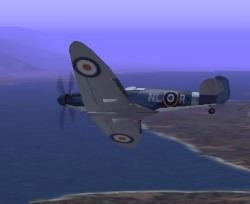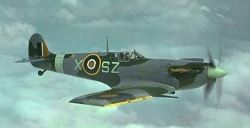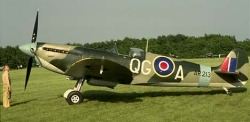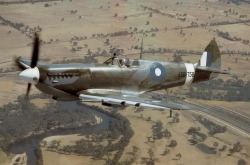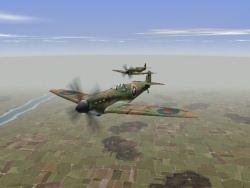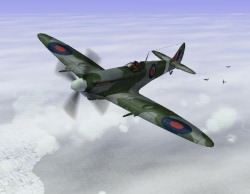| Flight Modeling in EAW, CFS and WW2 Fighters by Leonard "Viking1" Hjalmarson |
||||
|
Recently Ben Chiu wrote an article titled where he described the different approaches different sim designers have taken to modeling aircraft flight characteristics. I want to take off from part of his discussion to talk about my experience in Microsoft Combat Flight Sim, Microprose EAW, and Janes WW2 Fighters beta. I'll also throw in a comment or two on Activision's Fighter Squadron beta. Note that Fighter Squadron and WW2 Fighters are not quite complete, and any comments or observations on the flight model at present may not prove true in the final product. Note also that I am not a pilot nor an expert in aerodynamics! In his article Ben pointed out that there is no such animal as a perfect flight model. True, progress has been made, but all flight models to date still have "holes," even if those holes have become more theoretical than real with the best flight models.
I'm in agreement with Ben that there are three lenses through which to view flight modeling: performance, feel and function. Performance refers to how well the simulated aircraft matches the performance numbers of the real aircraft. Feel describes the subjective, and hardware dependent aspects of simulated flight. Function refers to cause and effect relations in the simulation: when X happens, Y should result. The first component is the easiest to perfect. Performance tables translate quite effectively into the simulation world, and the numbers are not difficult to come by. However, this becomes more tricky as we reach backwards in time, because measurements and the means of accomplishing them are not the same today as they were fifty years ago. In order to accurately model performance characteristics of WW2 warbirds, programmers rely on hard data as well as anecdotal data. In other words, scientific measurement is combined with pilot testimonies in order to approximate the performance and feel of the aircraft. That being said, I'd like to compare two aircraft across four simulators. We'll look at the Spitfire MK IX in Microprose' EAW, Activision's Fighter Squadron, Microsoft's CFS, and Janes WW2 Fighters from the point of view of performance, feel and function. I find the flight models in these simulations striking in quality, but I am intrigued by the differences at the high levels of realism. Stability Differences Before we get into the actual in simulator data, let's consider a framework of aircraft characteristics to better understand what we will be seeing in each simulation. Airframe stability exists along three axes: pitch (longitudinal), ailerons (lateral), and rudders (directional). In order to test a particular airframe for stability, pilots test pitch by pushing forward or pulling back on the stick. The test is simple. Take the aircraft to a comfortable cruise speed at 3000-5000 feet in level flight, then pull the nose up 20 degrees and let go of the controls. If the aircraft returns to level flight by itself, it is a positively stable airframe. This test performed on a Corsair will find the nose quickly returning to the horizontal. The highly manouverable Zero, on the other hand, is neutrally stable. Releasing the stick in a climb as described above will find the aircraft still climbing when it finally stalls. Negative stability is indicated by the reaction of the P-39 Airacobra. Releasing the stick in the test manouver finds the aircraft increasing its angle of attack: the nose continues to rise! The P51 Mustang is in a class of its own. Releasing the stick finds the hose bobbing about and slowly coming down to the stable position. The Mustang is a marginally stable air platform. With that background established, let's consider the Spitfire. Here is testimony from an actual pilot on some of the performance characteristics: Every Spitfire I've flown takes a bit more muscle to roll than most fighters. As speed increases both rudder and ailerons get heavier, resulting in a curious mismatch at high speed...one has to handle the almost oversensitive elevators with a light fingertip touch while arm-wrestling the stiff ailerons. Pilots had to keep this in mind during combat, particularly when going against the Fw 190 which had a sterling rate of roll and exceptionally well harmonised controls. That being said, the aircraft is very well balanced and delightful to manoeuvre. Whipping a Spit around the clouds ranks right up there at the top of aviation's great experiences. The aircraft stalls like a Piper Cub. Though a wing tends to drop, there isn't the slightest mean streak in it unless you cob the power, which produces a very violent torque roll. Power off, gear and flaps down, main fuel tanks full, it stalls at 65 kts, which is ridiculously slow. Add a slight bit of power and that drops to 60 kts. With that enormous snout, I try to make a curving approach to landing at about 100 kts in order to keep the runway in sight as long as possible. By the time I'm rolling out across the field boundary, if at max landing weight, I should be no faster than 85 kts with power and 95 kts in a glide. At lighter weights these speeds can be reduced by 5 kts.
All Spitfires are exceptionally easy to land with no inherent tendency to swerve or groundloop. Just reduce power to idle, flare to a three point attitude and she sets down on a feather almost every time. This is a great surprise to most considering the narrow track undercarriage and full swivel, non-locking tailwheel. Why doesn't it drop a wing violently or make the pilot stomp on the rudders? I wish I knew. The genius of managing to combine light aircraft characteristics with such high performance is nothing short of miraculous compared to most other wartime tailwheel types. One or two landings in the Spitfire and you are in love for life. The Late Jeffery Ethell, quoted from December 98 issue Flight Journal, "Flying the Spitfire".
Let's start with the assumption that Janes, Microprose and Microsoft are using essentially the same data for modeling performance characteristics in each of their simulators. According to a Microsoft programmer, this makes up 80% of the finished product. Once this data is in place, tweaking is done to get the right feel. Much of that tweaking is done in response to feedback from beta testers and pilot consultants. In many cases these pilot consultants have actually flown the real aircraft, and some of them still fly. As a result, while base performance should be the same, we can also expect the final model to vary somewhat, since different consultants are being used by different game companies. Furthermore, its likely that the translation of and implementation of the feedback given by actual pilots will also vary. That being said, I want to describe the differences I am seeing in the actual flight models in each of these simulations. Then we will refer back to our "resident" expert quoted above. First, European Air War. |
Stability and Stall Speed The Spitfire MK IX is more difficult to fly in EAW than in either MS CFS or WW2 Fighters. The overall response is more similar to WW2 Fighters, but the aircraft feels heavier in CFS or WW2 Fighters. (Incidentally, in all three simulations the Spit IX has a top speed of 340 knots at 7000 feet). The Spitfire IX in EAW is neutrally stable. Pull the nose up at level cruise of 250 knots at 5000 feet and the angle of attack remains the same until the aircraft stalls. I find myself in trouble more quickly in EAW, and I also find recovery more difficult. Stall occurs at a slightly higher speed than in either WW2 Fighters or MS CFS, and it's not as easy to tell when you are getting into an accelerated stall. For example, I flew a straight and level path at 6500 feet and cut throttle all the way back. I then attempted to hold the nose level for as long as possible. At 120 knots I began losing altitude with the nose level. At 100 knots I was dropping like a stone, and stall buffet began at around 90 knots. However, I was still in control of the aircraft. If I had dropped either wing at that speed I would have been out of control quite quickly. In Microsoft CFS and Janes WW2 Fighters the Spit IX is positively stable. Pulling the nose up at level cruise and releasing the stick results in a gradual return to horizontal. In CFS stall occurs at the lowest speed of the bunch and is least noticeable. At 6500 feet I was able to hold altitude until about 90 knots. In WW2 Fighters I could hold altitude with back pressure on the stick until about 100 knots. Stall buffet became noticeable at that speed also. Torque Effects and Aileron Roll Engine torque has a major impact on roll rate, as anyone who has flown the Sopwith Camel in Flying Corps or Red Baron II can tell you! On takeoff, failure to take account of torque effects in Microsoft Combat Flight Simulator or in Fighter Squadron will have you on one wheel and a wing tip quick as a wink. However, neither CFS nor EAW model the torque effect once you are in the air. A left aileron roll will take the same amount of time as a right roll, and cutting the engine has no effect. An aileron roll is the quickest in EAW, at about four seconds, and in MS CFS takes just over five seconds. (You can see the torque effect in CFS when you rev the engine as the plane pulls left, but for some reason this isn't reflected in roll rate). In WW2 Fighters, however, a right roll is much slower than a left roll. A left roll takes about five seconds, but a right roll at full throttle takes more than nine full seconds! Yet while torque effect is modeled in the air, it seems almost absent on take off (either this is going to change or torque is minimized on the ground to allow pilots an easier lift off. EAW also seems to ignore torque). Fighter Squadron models torque in the air, and is also the most challenging takeoff of these four simulations. Granted, the flight modeling may not be complete in either FSSD or WW2 Fighters, but I've found myself on the fence more than once trying to get off the runway in FSSD! (The over bounce on the springs has now been corrected, according to Michael Harrison). Watching the process from an outside view is also instructive. The aircraft gear compression is modeled and you will find it bouncing a bit if you overcompensate with rudders. After this battery of tests I became curious as to what would happen if I stalled one wing first when pulling a high AOA until stall, so I performed the same manouver again, starting a climb at 200 knots and 6000 feet. Then just when the stall effects could be seen I hit the rudder hard left.
In EAW there was initially no effect, and then suddenly one wing dropped away and I was in a spin. This didn't happen in either MS CFS or WW2 Fighters. However, attempting the same manouver in Fighter Squadron beta the response was more like EAW. Even before I applied rudder one wing began to stall and the aircraft started to fall off to the right. I attemted to compensate with rudder rather than let the aircraft recover itself, and I found myself in a nasty spin. A few moments later one of the wings snapped and I was in deep trouble. I did some experimenting with high speed dives in EAW and MS CFS, and the differences are substantial. In EAW the Spit IX is more responsive and manouverable than in MS CFS or WW2 Fighters beta. You are more likely to survive a high speed dive in EAW, but only if you don't black out while pulling high g's! In MS CFS a high speed dive is likely to get you killed. WW2 Fighters falls somewhere in between these two but is not as forgiving as CFS. This makes good sense of the feeling in EAW over all. The Spitfire in EAW is a less stable air platform than in either WW2 Fighters or MS CFS, and probably closer to Fighter Squadron than either of the other two.
Controller Issues One interesting facet of flight modeling and feel relates to the controller itself. I used my Thrustmaster gear exclusively for these flight model tests, and I also tested exclusively on a single system in an attempt to keep things equal (PII 300 with 96 meg SDRam running Matrox MGA G200 and Wicked 3d-2). However, I've also used three different sticks in each of these sims for comparison of feel and control accuracy: the Thrustmaster F22 Pro, the Logitech Wingman Force, and the Quickshot GenX 700. Each of these sticks has their own usefulness, but the latter is the most lightly sprung and therefore the quickest action. As a result, trying to fly EAW with the GenX is like trying to balance a quarter on edge. Flight becomes much more difficult, and my perception of the model is likewise canted. The impact of force feedback is quite interesting in this regard. With the most touchy model of these four simulations, EAW benefits the most from force feedback, and thankfully also has the most detailed force feedback model in place. WW2 Fighters and MS CFS, on the other hand, with a more weighty feel to the aircraft, seem less touchy and less affected by quick movements of the stick. Using a lighter stick with these sims won't be such a problem. Oddly, however, I've noticed that speed bleeds more slowly in Fighter Squadron than in MS CFS or EAW, and more slowly still in WW2 Fighters. It could be that drag is not as strongly modeled in the WW2 Fighters beta. Summary No flight model is perfect, and no single simulation will satisfy every virtual pilot. On the other hand, all these models are quite sophisticated, even if they emphasize certain aspects above others.... Its interesting that in EAW the Spit is neutrally stable, while in WW2 Fighters and CFS it's positively stable. This is an issue with the overall modeling of the characteristics of the aircraft, and it would be interesting to hear from someone "in the know" as to which is more accurate. In any case, each of these sims offers much more than a flight model, and unless you place flight model first in importance above any other feature, you will likely purchase one or more of these WW2 sims for other features.
|
|||
|
© 1997 - 2000 COMBATSIM.COM, INC. All Rights Reserved. Last Updated November 1st, 1998 |
||||

